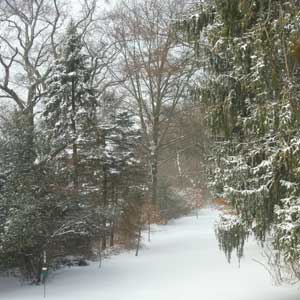
We had a white Christmas, the first one I can remember in a long time. It caught nearly everyone by surprise, including me and the weatherman.
The forecasts were largely for sleet-ish mixtures, nothing too much. I was pleased when, at daylight, we were having snow with driving winds, the conditions defining "blizzard" if they had continued for very long. That was much better than slush. I managed to go for my usual run on Crane Beech, beautiful and a lot of fun, though challenging with the wind was driving icy particles into my eyes. (I will have to try again to find goggles that don't fog up in the cold. There must be such a things.)
After lunch and a short nap, I looked out to see that there was an accumulation of several inches. The plows, as usual, had eased their job of clearing the street by moving everything onto the sidewalk. Well, an hour's work put things into good condition. We're supposed to have a very cold snap for a week. It seems like a good idea to take care of snow removal before that.
Anyway, merry Christmas, from Paul, who is a tiny bit sore from all that activity.

We're having our first snow of the season. It is so peaceful. It's midday Saturday. There is scarcely anyone out at all. People have mostly managed to get their scurrying done during the morning, and all have retreated to the warmth of their homes.
(In a while, we'll all have to venture out and deal with the task of clearing, but for now that's vague, distant future.)

Looking through some old pictures, I happened across this one of me, holding my mother's hand, in her late, profoundly demented days. I find it profoundly striking. To quote from her blog,
I love to shake hands and will go on as long as you will keep shaking hands with me, up and down, up and down, back and forth. It is like a baby being happily dandled on its mother’s knee. Sometimes when Paul comes and we shake hands in the hallway, I don’t want to let go so he can get in the back of the wheelchair to push me to my meal. So, what we’ve worked out is that Paul walks down in front of the wheelchair with his arm out to me, and I hold on and I roll down the hallway behind him, like a chariot in tow.
Kathy (one of the nurses here, a very nice person) reports to Paul that I was singing a soft song earlier this afternoon, shaking hands with her in time to the music, very happy with it all.
What does this have to do with Thanksgiving? Well, it is the thought of my mother, ![]() profoundly happy and grateful for the smallest gesture, at a time when she was near-paralyzed and radically demented, a life that most people would consider beyond miserable. We should all take life in the same spirit.
profoundly happy and grateful for the smallest gesture, at a time when she was near-paralyzed and radically demented, a life that most people would consider beyond miserable. We should all take life in the same spirit.

My somewhat peculiar set of personal interests includes family history, which fits into a general enjoyment of puzzles. As I've noted here earlier this year, the most puzzling branch of my history has been the Lloyd arm. For three generations, the ascent went through wandering lowlifes and ne'er-do-wells, with unremarkable lives and solitary, meandering paths.
A recent breakthrough was learning that there was a five to ten year interval between one member taking leave of the Society of Friends in England and establishing himself in the Society of Friends in America. Learning of that unexpected twist helped me resolve many apparent contradictions and come to a story that I feel comfortable with.
The Lloyds in my family thought that the line led up to illustrious forbears with titles and coats of arms. I shrugged this off, since just about every amateur of genealogy expects to find such celebrated ancestors. It turns out that they were right. By all traces that I can find, the humble folks I've been studying for the last two decades came from the Lloyds of Dolobran. That line is noted for including Charles Lloyd, an early associate of George Fox, founder of the Society of Friends; Sampson Lloyd, founder of Lloyds Bank of London; and Thomas Lloyd, who accompanied William Penn and was the first Governor-General of Pennsylvania. Not bad.
I've posted a detailed white paper on my Family History page. In updating my interactive family tree there, I have followed Burke's Genealogical and Heraldic History of the Landed Gentry. Though a bit fanciful and overambitious in its reach, that version is commonly circulated and consulted, and there is almost no possibility that I would be able to do better with the ancient history.
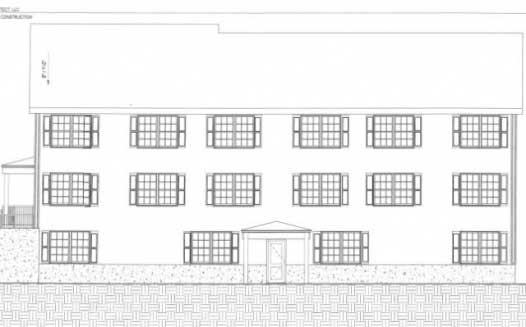
Massachusetts law provides a mechanism to promote the creation of affordable housing in communities that have little of it. So far, so good as a notion: no one believes that housing should be unaffordable, and affluent localities will be unlikely to do much toward the goal in the absence of suasion from the more general body public. It's like the issue of moral hazard in the purchase of health insurance: people who are sick are much more prone to want insurance than people who are well, and incidentally probably less able to afford it. This tends to shift the burden of payment away from those who will benefit from it, which loses viability in the absence of either a highly unusual degree of altruism or some sort of individual mandate. In the absence of such a mandate, the less fortunate face a downward spiral.
Designing and implementing a scheme to make housing accessible to all is no easier or less controversial than making health care available to all, with financing agreeable to all. Massachusetts General Laws §40B allows developers to apply directly to the State for a determination that a proposed project is suitable as affordable housing. Upon approval, the developer may proceed in a streamlined local review and approval process, with the presumption that the benefit of creating affordable housing will secure substantial exemption from zoning restrictions. Various levels of negotiation and appeal are possible. The proposal need include only a minority number of affordable units, which is a realistic recognition of the economic reality that housing – particularly in this state – is an expensive commodity.
A developer has applied for approval to build an eight-unit project just up the street where I live, which is one of single-family homes. Despite my general support for the concept, the particulars of this proposal, in the description of the Chairman of the Board of Selectmen, stink. I don't think the developer is a bad person. I do think that he has his blinders on. I've told him a couple of times that I think he would have a hard pull of it, but he's been determined to go ahead. That is his privilege.
I've helped organize and mobilize the neighborhood in opposition, having found a while ago that such forces can be extremely powerful. The experience was interesting. I was extremely careful not to tell people what they should think, only communicating what was happening and how they could have a voice in the process. The universal reaction was horror and disgust with the proposal, without my voicing any opinion. The neighborhood has people from all walks of life. As John le Carré remarked, you don't choose who's next to you in a protest march. I'd like to think that the activity tended a bit more to the high ground than to mud-wrestling because of my involvement, but I don't know that.
In any case, opposition has so far been very successful, with the Town Selectmen voting strongly and unanimously against the proposal. Perhaps they would have done that anyway, but I suspect would have left the door open to compromise, a common approach when people disagree. In this case, I don't feel that compromise is a viable solution. We'll see where things go from here.
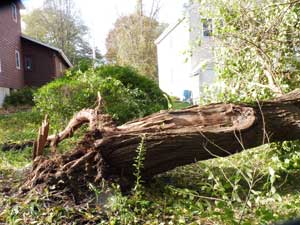
The very gradual process of global warming is difficult to see in daily life, disguised as it is by the great random variations from day to day and year to year. Climate change is much more evident experientially in the increased variability of weather events and trends.
In September 2104, three years ago to the day, I had my first personal experience of being in a microburst, a mini-mini-cyclone. This took a 75-foot Norway spruce close to my house, and left standing two similar trees right next to it.
In the winter of 2014-15, we had the snowiest and second-coldest winter on record for this area. We had eight feet of snow in the single month of February.
The following winter was abnormally warm. In late February, the temperature was 57° and I was outside doing spring gardening chores in the unfrozen ground. The summer was the driest on record.
The winter of 2016-17 was relatively mild. The spring and summer were the rainiest ever.
Early yesterday morning, we had a few hours' storm with winds gusting to over 60 mph. A few hours after that the storm had blown away, but not before taking down some very large trees. One of these is shown in the picture above. This very large silver maple was quite old and visibly leaning, the remaining half of a double tree whose other branch succumbed a few years earlier. It was not a surprise to see it come to the end of its days.
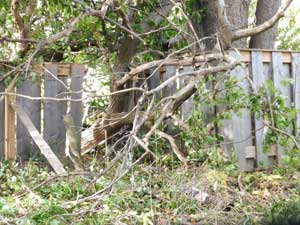
It did some relatively minor damage to the fence I put up a few years ago, but that will be easily enough repaired.
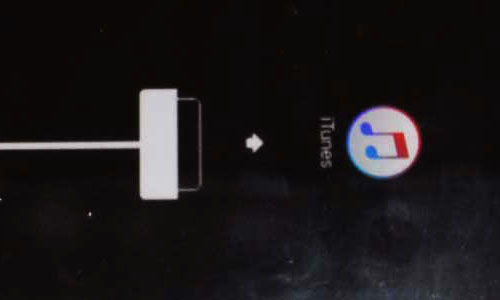
I bought an iPad fairly early on, as witness that its model name is iPad 2. That was in 2011. I expected that I would get two years of use out of it. I've had six. In those days, when I was spending two hours a day on the commuter rail and three with my mother, it was invaluable. After a while, I upgraded to a newer model with cellular capability. I kept the old one for odd tasks and occasional use on the second floor of my house. At this point, I have about zero use for travelling electronic devices, since I'm generally at home or out in nature, where I want nothing to do with such things.
This morning, the iPad 2 gave me notice that it needed a software upgrade, which apparently it couldn't have because it was too old and no longer supported. Well, that's reasonable by the standards of this age of throwaway electronics. I find it interesting that it was still working when Apple forced the impossible upgrade.
I may get a replacement, perhaps a small device that fits the two or three uses I have for it. But I'll try going without for a while. Maybe I don't need anything at all.
As luck would have it, my fifteen-month-old washing machine died this morning, displaying error code E4. Looking that up, I find it is a message that the machine can't get water. Well, it's full of water now, so it's beyond my trouble-shooting capabilities. Fortunately, I purchased a five-year warranty plan – very atypically, because I almost never go for extended warranties.
All in all, two pieces of bad luck, one right on top of the other, hardly add up to anything at all between both of them.
Retirement has been even better than I'd imagined. The key interests and activities of my life have flourished. My art, in particular stonework, are at their high point. I delight in my piano, playing every day and managing to accomplish things I've never before been able to. My reading continually finds unimagined parts of the world and new insights. I've taken up running, which I hadn't done since high school physical education classes called for two laps around the gymnasium. I go every morning, weather permitting, when some other pre-empting commitment doesn't take me elsewhere.
I am fortunate in enjoying good health and not having financial worries. The years of work on my house have left only relatively small things to be done with it. Putting in air conditioning this year was expensive, but I have been extremely glad that I did. The heat and stickness this summer would have made for an extended period of misery without it.
To be sure, there are things that might have gone – might be going – better. Neither my body nor my mind have a lot of energy in the evenings, which often leave me puzzled about activity. Daily life offers many opportunities for casual contacts with my fellow creatures, but few for more than that. Of course, I am conscious that my good health will not go on forever, though there are no obvious threats to it that I can see. Indeed, I think the understanding that there are a finite number of years left gives me a greater incentive to make the most of each one.

The Town of Ipswich, where I live, has an annual arts show. It's small and unpretentious. It's rather fun. I've visited it at irregular intervals.
This year, for the first time, I entered the show with a couple of pieces of my own art. Because people of this seaside community generally like marine themes, I selected my recent octopus and somewhat older oyster shells.
The octopus won the prize for best in show. That was rather nice, especially because it was the first time I've exhibited anything in my post-student life. Occasional moments of small success are good for all of us, the more so if they're unexpected.
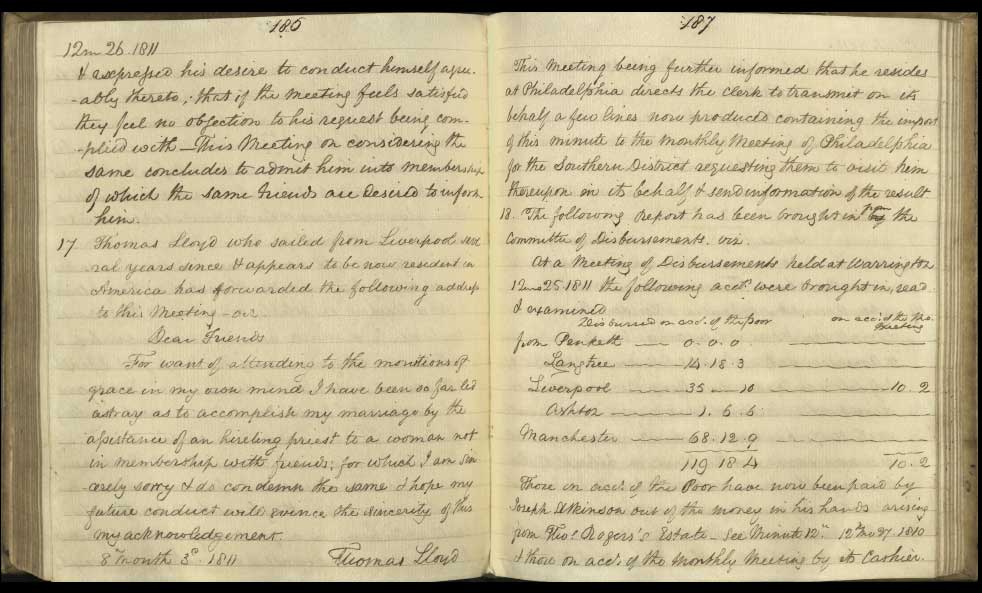
I've been pursuing my family history for a couple of decades now. Curiously, much of my interest was prompted by the interest of my grandmother Esther Lloyd in her ancestry, and the Lloyd line has been the hardest to trace. For at least three successive generations, the bearers of that name had unstable and wandering existences, including separations from their wives. (I am glad that my grandmother did not have an opportunity to learn more about them. She would have been mortified.)
Recent information from the records of the Hardshaw Monthly Meeting of the Society of Friends in England has brought me to comfort with identifying the last unknown member of the seventh generation of my ancestors, one Catharina Oblinger, farmer's daughter of Northampton County, Pennsylvania, born about 1780. I'd known that she and Thomas Lloyd were married, but from the face of things had believed she was probably a second wife, and so step-mother rather than mother. The new information is that Thomas arrived in America perhaps a decade earlier than was apparent. The Friends documents speak for themselves:
Thomas Lloyd who sailed from Liverpool several years since & appears to be now resident in America has forwarded the following address to this Meeting - over.
Dear Friends
For want of attending to the monitions of grace in my own mind I have been so far misled astray as to accomplish my marriage by the assistance of a hireling priest† to a woman not in membership with friends; for which I am sincerely sorry & do condemn the same I hope my future conduct will evince the sincerity of this my acknowledgment
8 mo. 3d 1811 Thomas Lloyd
The Meeting being further informed that he now resides at Philadelphia direct the clerk to transmit on its behalf a few lines now produced containing the import of this minute to the Monthly Meeting of Philadelphia for the Southern District requesting them to visit thereupon in its behalf & send information of the result.
*Thomas could not read or write, so presumably he had help with this letter, which indeed is quite refined in its tone and language.
†An expression of Quaker founder George Fox expressing contempt for the established ministers who lived in comfort, supported by the tithes of their congregations. Marriage outside of the community of Friends was grounds for dismissal.

I have very much enjoyed my stonework over the summer, but I am quite conscious that the extent of time devoted to it has kept me from other deserving things.
My yard has a perimeter of 1,173 ¾ feet, more or less, as close as I've been able to figure out. Nearly all of that was fenced by the various neighbors when I came seventeen years ago, but time has taken its toll. I did the first replacement three years ago, and this spring added a small new section to screen the incoming air conditioning equipment. Meanwhile, much of the current structure on the northeast property line has sagged or fallen.
I find a curious pleasure in building fences, including the process of digging post holes. Sometimes they're easy, sometimes they're difficult, with buried stones and crossing roots. It's sometimes a challenge, but a challenge one can set aside the second whimsy suggests, and resume the minute it seems worthwhile again. What could be better?
So, I'll pick it up again for a while, working toward the far corner. Setting the posts is about half the work of building a fence, so I'll make it my goal to set posts for 80 or 100 feet of fence this fall. In a few months, when spring fever comes, I can do the visible carpentry part.
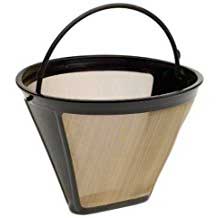
Most of us have our peculiar economies, conserving the smallest and most commonplace things rather than using them for their intended purpose. Elizabeth Gaskell reported that her was rubber bands. "I have one which is not new – one that I picked up off the floor nearly six years ago. I have really tried to use it, but my heart failed me, and I could not commit the extravagance." In the same way, we have things for which we would never spend the slightest money, no matter how rewarding that might be.
For whatever reasons, I hate rinsing out the coffee filter. The tap water is always cold and clammy at the logical moment, and the black grits make a mess of the kitchen sink. Putting the filter in the dishwasher is a wonderful alternative, except that I usually run the dishwasher in the wee hours of the night, after the coffeemaker is set up for the coming morning.
It took me many years to realize that I could have two coffee filters, one for active use and the other in the dishwasher. The cost of a second filter was $6.51, plus sales tax. When this idea dawned on me, I felt it was a flash of genius. Of course, I couldn't proceed right away, because there would have been a slight shipping charge. Instead, I waited until I had accumulated enough other purchases to get free shipping from Amazon.
We are not a very logical species.

My mother ![]() lived a very "healthy" lifestyle, as far as health is commonly understood, and tactics for promoting it are accepted. She ate a lot of salads and whole-grain bread, long before there was much idea that these were "healthy." She just liked salads and vegetables and grains. She got a lot of exercise, not as a goal-oriented chore, but because she was full of energetic love of all kinds of activity.
lived a very "healthy" lifestyle, as far as health is commonly understood, and tactics for promoting it are accepted. She ate a lot of salads and whole-grain bread, long before there was much idea that these were "healthy." She just liked salads and vegetables and grains. She got a lot of exercise, not as a goal-oriented chore, but because she was full of energetic love of all kinds of activity.
Despite her healthy diet and lifestyle, she succumbed to an illness of the sort to which wild horses couldn't have dragged her, if she could have understood what was going on. She didn't, but I did.
I was amazed at the diet that the obese community in her nursing home espoused. She gained ten pants sizes in a year. I worked, with partial success, to clean up the institutional diet of sugar and starch. Faced with the reality, I cleaned up my own diet. I lost 35 pounds over several months and have kept that excess weight off for over five years.
I have a cheeseburger once a year, on the Fourth of July. It's a ritual, a rite, and as with other events of the kind, one can wonder whether the celebration is a matter of high choice, or a simple marker of the passage of time. I've tried many variants and recipes, usually ending up – as this year – with cheddar cheese, a bit of fresh thyme, and a slice of onion.
As part of the ritual, I treat myself to craft beer – or ale, which I somehow prefer, without being able to identify quite why. Somehow, this year I craved stout and searched the internet for options and reviews. The top rating was for Trillium Brewing, not very far from my recent workplace. Unfortunately, I couldn't find their products close to my home. I settled for a relatively expensive ale from Kentucky, and a stout from Ipswich Ale, a quarter mile from my home. The Kentucky ale was so-so, by my taste and by the ratings I subsequently found. The Ipswich Ale stout had a rating of 100 – world class – on the internet, which matched my experience of it. As I find more and more in all things, the best answers are close to home.
Was the cheeseburger good? This year, not particularly, although sometimes before it has been. The kitchen was very smelly afterwards, though I had the exhaust fan on high and took great pains to avoid allowing grease to splash about. – I do think I'll look into the Trillium ale. We'll see if it lives up to expectations better than the cheeseburger.

Reading is a big part of my daily life, as are music and art. It was an oddity to have my books largely stored in cardboard boxes for many years. With the acquisition of new shelves, it feels as if a part of me that was buried is now visible and part of my surroundings. That is very satisfying.
In the end, the estimated fifty feet of shelf space needed was accurately sized to within an inch, not only overall, but in having logical breaks between different types of content. The only things that don't quite fit are a handful of oversized volumes, such as art and musical scores, as I expected in advance.
It was a very interesting exercise sorting through my books in preparation. As of present count, there are 610 volumes. Of these, 362 are in English, 91 in French, 110 in German, 22 in Italian (my most recent language), and 35 in other forms (bilingual editions or musical scores). There are upwards of a quarter of a million pages altogether.
It has been an curious and revealing exercise grouping them by Library of Congress (LOC) catalog category. It was no surprise to see that the lion's share of the books fell into the LOC "literature" groups, further subdivided by language, then period, and then author's name. It was interesting to see what wasn't there. There were no books for LOC headings U (Military Science) or V (Naval Science), and I don't expect that there will ever be. There was a single book in heading G (a curious group described as Geography, Anthropology and Recreation). That was Bruno Bettleheim's The uses of enchantment, which is really literary criticism or perhaps notes on childhood development. There was one in heading K (Law). There was just one in heading J (Political Science), a surprise to me. There were a lot in M (Music) and N (Fine Arts), as I would have expected. There were two in S (Agriculture) and one in Z (Bibliography, Library Sciences, and Information Resources). – I'd like to use the experience to identify areas where my reading is weak, especially where unintentionally so. That will take a bit more head-scratching, though.
Here, I've updated the format of the Reading pages of this web site, replacing the "Recent" lists, which have become haphazard, with "Library" lists. After a little time, this seems more logical and intuitive than any alternative I've considered. I've redone the linkage scheme and favorites listing, which is probably overdue housekeeping in any event. Over time, I'll also weed the comments on individual works to be more selective, perhaps filling out the roster with a few thoughts on old favorites.

My experience has been that this area has about two weeks of summer weather that are very unpleasantly hot and humid. Somehow, I've found ways of getting through the hot spells. At this point, climate change seems a clear reality, and I'm spending most of my life at home. A noisy room air conditioner for the bedroom, which might otherwise get over 95°, has been minimally acceptable approach for hot nights, but the rest of the house gets just too hot for me to go about my normal activities.
I've recently signed a contract to have ductless air conditioning installed. My small old house was never designed for such things, but I'm hopeful that it will deliver moderate temperatures without objectionable noise. It's scheduled to be done at the end of May, taking three days' work.
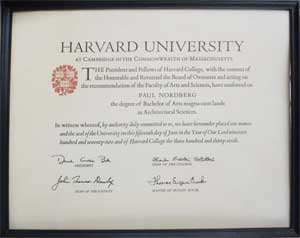
I have made nothing of my diplomas since completing school. I gave them to my parents – who enabled them, and who cared more about the symbols than I did. For many years, they hung in the house in Fox Point, along with their diplomas.
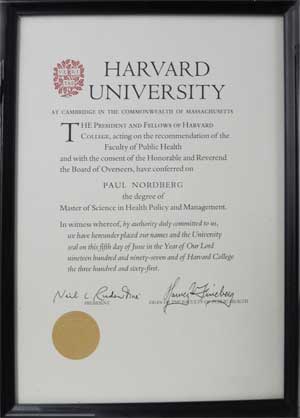
Recently I have been making good progress at sorting through the last of the remnants and few cardboard boxes from clearing of the house there,![]() generally making it a rule either to find a good place and use for things, or to throw them out. So, I've hung them up. I do value my education enormously, and it won't be pretentiousness for me to have them in my own study.
generally making it a rule either to find a good place and use for things, or to throw them out. So, I've hung them up. I do value my education enormously, and it won't be pretentiousness for me to have them in my own study.
Aside from the general family climate of caring about learning, my mother's getting her Ph.D. at age fifty gave me a role model to follow. I am very glad that I had that example, for it worked out very well.
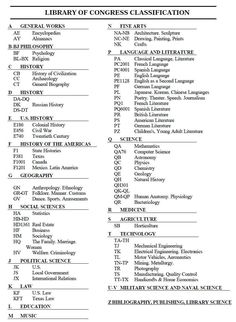
I have many books. An amazing number of them are in cardboard boxes, despite some heavy weeding and strategic placement of key items. Yesterday, after some measurement of books and furniture space and calculations, I ordered shelves for them. I'm not sure that I have the right capacity, but anything in addition to what I have now will be a blessing, and anything unused will be soon filled.
The prospect of having such a luxury as bookshelves, and a fresh start, raises the question: what will I put where? – People, if they have books, generally have them arranged in a happenstance fashion, with occasional interludes of partial organization. Size can be a determinant.
When you think about the question, how does one organize books, a rather obvious thought is that others have thought about this question before. Most of us have run across the Dewey Decimal System, commonly used in general libraries. The Library of Congress system is more common in academic collections, which mine approximates in style if not in size. There are subspecialties, such as the British Library of Music and National Library of Medicine systems.
It's an amusing question to think about, how do you put everything in the world and beyond into a logical row? Roget struggled with the same conundrum, more or less, when he set up his Thesaurus. There's no good solution, but one has to pick something.
The Library of Congess (LOC) system seems to have something going for it. Still, it is dated, with such groupings as Category B, an outdated and hopeless mishmash of philosophy, psychology, religion. (My father observed the same about the Dewey Decimal System.) One LOC subcategory is BF, psychology, which covers a lot of ground. Another subcategory is BS, the Bible. The Koran doesn't have a comparable place. My collection includes both of these books. It seems, somehow, that they should be close to each other.
I like that the LOC gives consideration to language in literature. PR, a subset of P, Language and literature, is English literature, PT German (and other northern European) works. PR encompasses French, Italian, Spanish and Portugese, which makes sense given the closeness of the languages but doesn't given the enormity of what's in each.
We'll see. I hardly will need a card catalog or electronic database with the size of my library, but it would be nice to have some order to where things are.
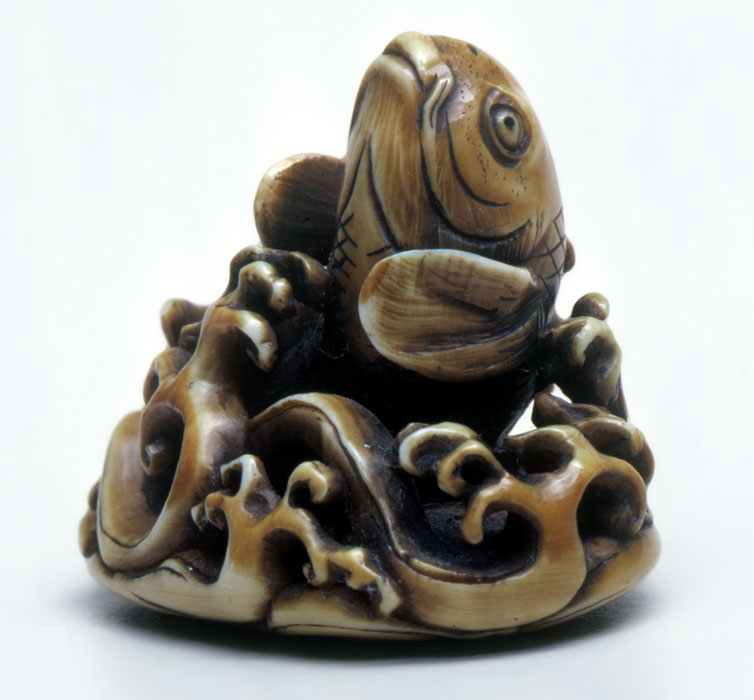
I have started a program of visting art exhibitions and museums, an activity that was on hold for many years. ![]() I am hoping that, among other things, these visits will broaden my perspective on my own artistic activities.
I am hoping that, among other things, these visits will broaden my perspective on my own artistic activities.
I have been very struck with how much I am been looking at is a matter of the style the artists are working in, and how relatively small is the contribution of individual creativity or skill. (Of course, part of it is that museums organize their collections and shows in such categories and families.) The style usually has some apparent cultural side. For instance, early Americans wanted portraits that captured their individuality, warts and all. Their clothes didn't need to be individual, but they did need to be fashionable. Japanese ukiyo-e woodblock prints rarely made even an effort to display the individuality or reality of the persons represented, with the feeling that a harmonious composition was the important thing. Clothes did need to be fashionable. The artistic representations of clothes were quite flat and spaceless, appearing much like scissor-cut samples from the bolts of fabric. Indeed, sometimes the sellers of the art also sold fabrics like those worn in the pictures. I suspect that the attraction of the prints followed transients modes and styles that our modern eye doesn't notice. The were, after all, in the business of making prints! Along the Atlantic seacoast, where I live, people wanted pictures of boats, fish and ocean storms. Those were major factors in their livelihood. It was the subject matter that was – and still is, hereabouts – important, not how or how well the representation was done.
Of course, individual artists may break from the mold and head off in new directions, or simply be very talented and accomplished without being hugely original.

I recently ran across the suggestion that sandbags are an essential of the stonecarver's craft. The author elaborates that he makes his from the legs of old work pants.
I haven't done much sewing beyond an occasional shirt button since I was young. The local dry cleaner has taken care of most of my alteration and repair needs. Manufacture of sandbags seemed a bit out of their line.
I broke out needle and thread and set to work at it. Though not a practiced seamster, I imagined that a few feet of hemming would be within my competence. It was quite a bit harder than I'd imagined, though. The thread had a way of winding around itself and getting tangled up, I guess because I unintentionally rotated the needle during each stich. Making a straight line with even stiches was a challenge.
It made me think of the times when sewing was woman's work – which it probably still is, de facto if not de jure. In the early days of my life, my mother made a lot of clothes, probably because it was cheaper than buying them, as well as being part of a wife's role. And she could buy ready-made cloth and patterns at the store, and use a sewing machine! Not so very long ago, people spun and wove by hand. Getting a new coat was an investment, perhaps something like getting a car is today. People described in their wills who should get which article of clothing.
At any rate, I eventually managed to turn out a creditable pair of sandbags. The suggestion was a good one. After short use, I don't know how I would do without them.
© 2025 Paul Nordberg